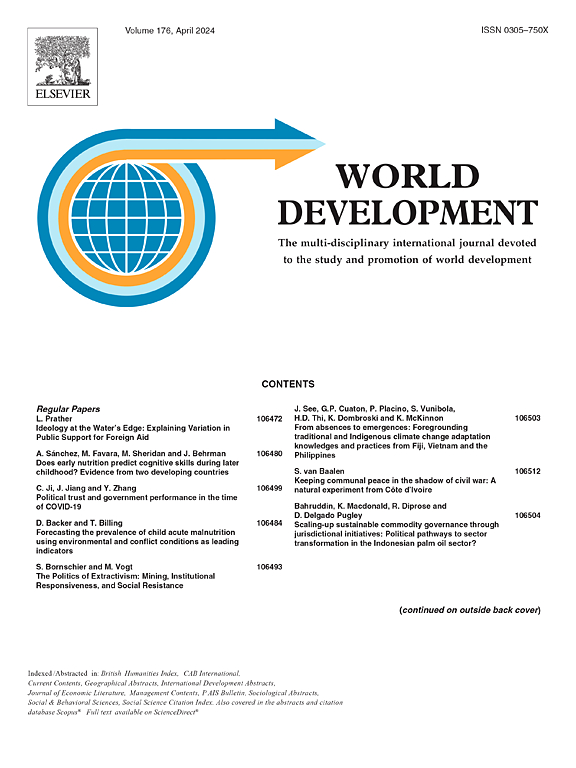Trajectories of labour market transitions in the Indian economy
IF 4.8
1区 经济学
Q1 DEVELOPMENT STUDIES
引用次数: 0
Abstract
The Indian economy, despite registering high growth, is characterised by a persistent and vast informal economy. Using it as an illustration, we draw lessons for characterising labour markets in contexts of high informality. We employ a group-based statistical modelling method to identify whether there exist systematic patterns in the high volume of worker transitions across different employment arrangements. Using panel data for eight points between 2017 and 2019, we identify seven dominant labour market trajectories. The trajectory capturing stable formal salaried employment, with highest average earnings, accounts for only 6.7% of the sample. None of the dominant trajectories denote a job ladder from informal to formal work, and the sorting of individuals into informal trajectories is far from voluntary, indicating an existence of formal and informal segmentation. The most populous trajectory, comprising 38.4% of the sample, with second highest average income (although half of that of the formal salaried trajectory), is stable self-employment, followed by the trajectory representing transition within different forms of informal wage work at 27.2%. Most trajectory groups associated with informal wage arrangements have high flux, indicating lack of stability. Furthermore, trajectories associated with informal wage employment have even lower earnings than those with informal self-employment. Far from suggesting a desirability of informal self-employment, this is indicative of a breaking down of the expected voluntary transition from self to wage employment in the transformation process. Additionally, access to trajectories is stratified along various correlates, especially caste. Caste hierarchy operates most starkly at the node of accessing the trajectories, while in terms of penalties or gains in earnings, traditional caste-hierarchy may not always operate uniformly. Our findings disrupt the standard expectation in structural transformation models and labour market theories, while highlighting the need to foreground evolving nature of informality in labour market models for developing economies.
印度经济中劳动力市场转型的轨迹
尽管印度经济实现了高增长,但其特点是非正规经济持续存在且规模庞大。以此为例,我们得出了在高度非正式背景下描述劳动力市场特征的经验教训。我们采用一种基于群体的统计建模方法来确定在不同就业安排下的大量工人过渡中是否存在系统模式。利用2017年至2019年8个点的面板数据,我们确定了七个主要的劳动力市场轨迹。平均收入最高的稳定正规受薪就业轨迹仅占样本的6.7%。没有一个占主导地位的轨迹表明从非正式工作到正式工作的工作阶梯,个人进入非正式轨迹的分类远非自愿的,表明存在正式和非正式分割。人口最多的轨迹,占样本的38.4%,平均收入第二高(尽管是正式领薪轨迹的一半),是稳定的自营职业,其次是代表不同形式的非正式领薪工作过渡的轨迹,占27.2%。大多数与非正式工资安排有关的轨迹组具有高流动性,表明缺乏稳定性。此外,与非正规领薪就业相关的轨迹的收入甚至低于非正规自营职业的轨迹。这绝不是暗示非正式自营职业的可取之处,而是表明在转型过程中预期的从自营职业到领薪就业的自愿过渡破裂了。此外,进入轨迹的途径是根据各种相关因素分层的,尤其是种姓。种姓等级制度在进入轨迹的节点上最为明显,而在惩罚或收入增加方面,传统的种姓等级制度可能并不总是统一运作。我们的研究结果颠覆了结构转型模型和劳动力市场理论的标准预期,同时强调有必要在发展中经济体的劳动力市场模型中突出非正式性的演变性质。
本文章由计算机程序翻译,如有差异,请以英文原文为准。
求助全文
约1分钟内获得全文
求助全文
来源期刊

World Development
Multiple-
CiteScore
12.70
自引率
5.80%
发文量
320
期刊介绍:
World Development is a multi-disciplinary monthly journal of development studies. It seeks to explore ways of improving standards of living, and the human condition generally, by examining potential solutions to problems such as: poverty, unemployment, malnutrition, disease, lack of shelter, environmental degradation, inadequate scientific and technological resources, trade and payments imbalances, international debt, gender and ethnic discrimination, militarism and civil conflict, and lack of popular participation in economic and political life. Contributions offer constructive ideas and analysis, and highlight the lessons to be learned from the experiences of different nations, societies, and economies.
 求助内容:
求助内容: 应助结果提醒方式:
应助结果提醒方式:


